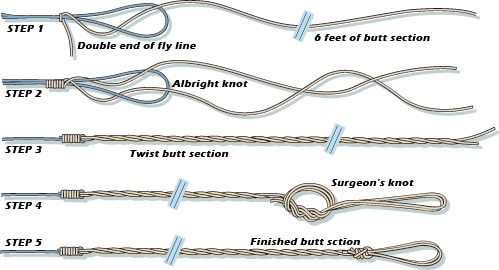
One of the things I love about fly-fishing in salt water is that there are so many ways to do things. My particular passion happens to be rigging, so any time I see a new way to solve a tackle issue, I am in seventh heaven.
Several issues back we covered fly-line-to-leader-butt connections for big fish, but since that time, I came across a new method of attaching fly line and leader butt. I want to share it with you, as I feel it has several advantages.
Hartman’s Hitch
Capt. Grant Hartman (www.baja-anglers.com) is one of the world’s foremost authorities on fly-fishing for roosterfish, striped marlin and Pacific yellowtail. He gets plenty of practice, making his home at the intersection of the Sea of Cortez and the Pacific Ocean at Cabo San Lucas.
Over the years Hartman has tried all the different methods of connecting leader butts to fly lines: nail knots, whipped loops, braided loops – you name it, he’s tried it – and broken it. One particularly tricky application is with monocore fly lines, which are notorious for parting under pressure when nail knots aren’t seated properly.
Hartman’s solution is an interesting one. There are few stronger knots than an Albright Special, named after the late, legendary Keys guide. It is one of the strongest, most basic line-to-line connections available. Its only drawback is that when tied in the traditional manner (with a single standing strand of monofilament, and trimming that tag end after completion), the knot doesn’t taper very well and consistently hangs in the guides.
But after several years of experimenting, Hartman found a method of tying that allows the knot to taper and makes for a stiffer, furled butt section which turns bulky flies over better. Bear in mind that this method works well for a loop-to-loop system that allows anglers to quickly change between pre-rigged tippets, and not so much for knotted, tapered leaders.
Getting Started
In order to use this connection, if you want to create a butt section with an approximate length of 6 feet, you’ll need to start with 12 feet of mono. Traditionally, on lines that are 7- to 9-weight, you’d use a single strand of fairly stiff, 60-pound monofilament to form the butt section. Because this method results in a furled butt section (doubled and braided), it’s possible to drop that down to 30-pound and obtain the same result with regard to turning over the leader and fly.
Hartman starts out by doubling the fly line over to form a loop (Step 1). He then passes the monofilament butt section through one side of the loop of fly line.
Using the tag end of the leader butt, he ties an Albright Special (Step 2) by wrapping the monofilament around itself and the loop six times, making sure that at the end of the knot, the tag end leaves the loop on the same side as the standing line enters the loop, to prevent the knot from binding under pressure and cutting the fly line. Lubricate the monofilament and fly line with saliva and pull squarely on all four strands to tighten the knot. It should pull down into a barrel.
Now rather than trimming the tag end (which would result in an unbalanced knot that would hang), Hartman takes the tag and standing pieces of monofilament and twists them together, forming a furled leader the entire 6-foot length (Step 3).
Once you’ve reached the end of the leader butt, tie a traditional surgeon’s knot in the end of the leader by doubling the line and tying in a double overhand (Step 4). Again, lubricate the monofilament and tighten both sides of the knot evenly.
Trimming the tag end of the surgeon’s knot, you’re left with a stiff, furled leader that will turn over heavily weighted flies into strong winds.
If you are planning on fishing sinking lines, it’s a good idea to keep the butt section short, no longer than about 3 feet in length.
The End
Although Hartman’s leader-butt system was originally devised for putting maximum pressure on big fish like yellowtail, roosterfish and billfish, I’ve since used it inshore on a number of species, including striped bass, bluefish, snook and tarpon. For spookier species like permit or bonefish, however, I still find a knotted, tapered leader is more effective. Hartman’s system is a perfect choice for applications where you’re going to need to change flies often.
Once the leader butt is finished, it’s up to you how to finish things off. I usually tie a traditional IGFA-style leader with a Bimini twist or a spider hitch in each end. (If using 12-, 16- or 20-pound on species where shock tippet isn’t necessary, you only need a double line on one end for the surgeon’s knot that will loop to the butt section.)
If attaching shock tippet to the terminal end, I’ll usually use a Huffnagle or surgeon’s knot for the heavy-to-class connection.
This new method of attaching your leader butt is perfect for heavy-lifting situations, but it will also help deliver your payload to inshore species as well. Give it a try. I hope you like it as much as I do.









